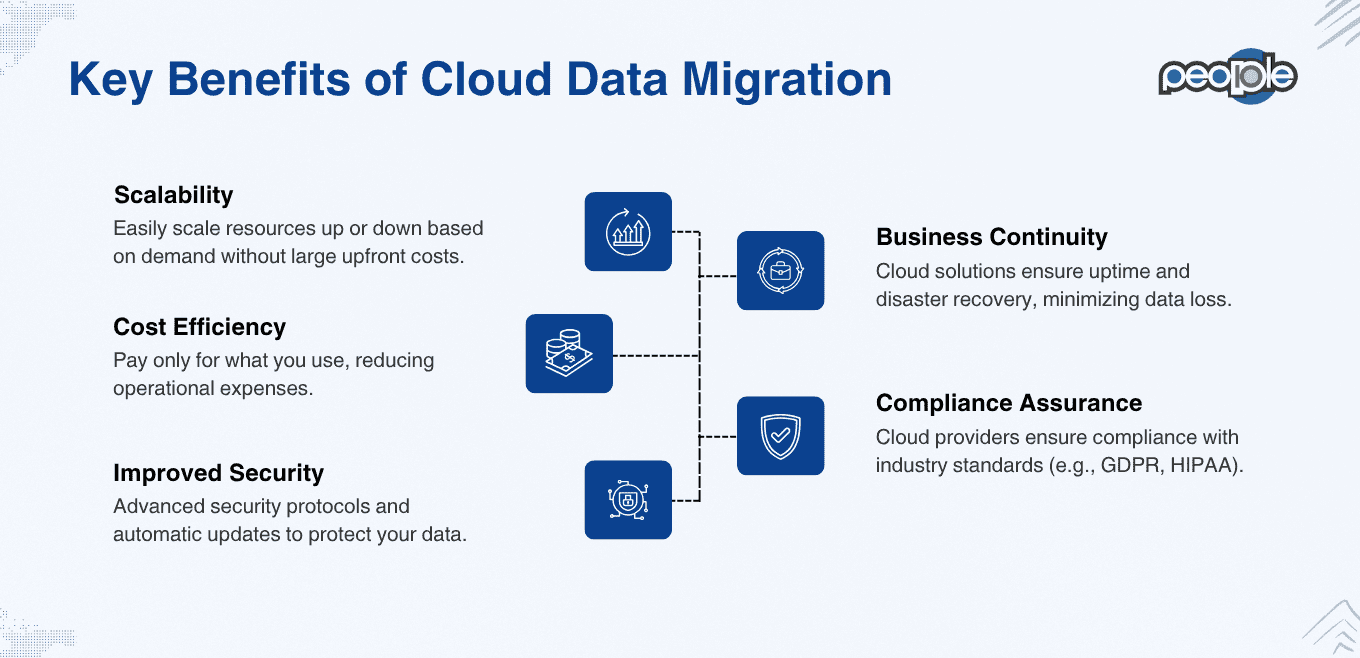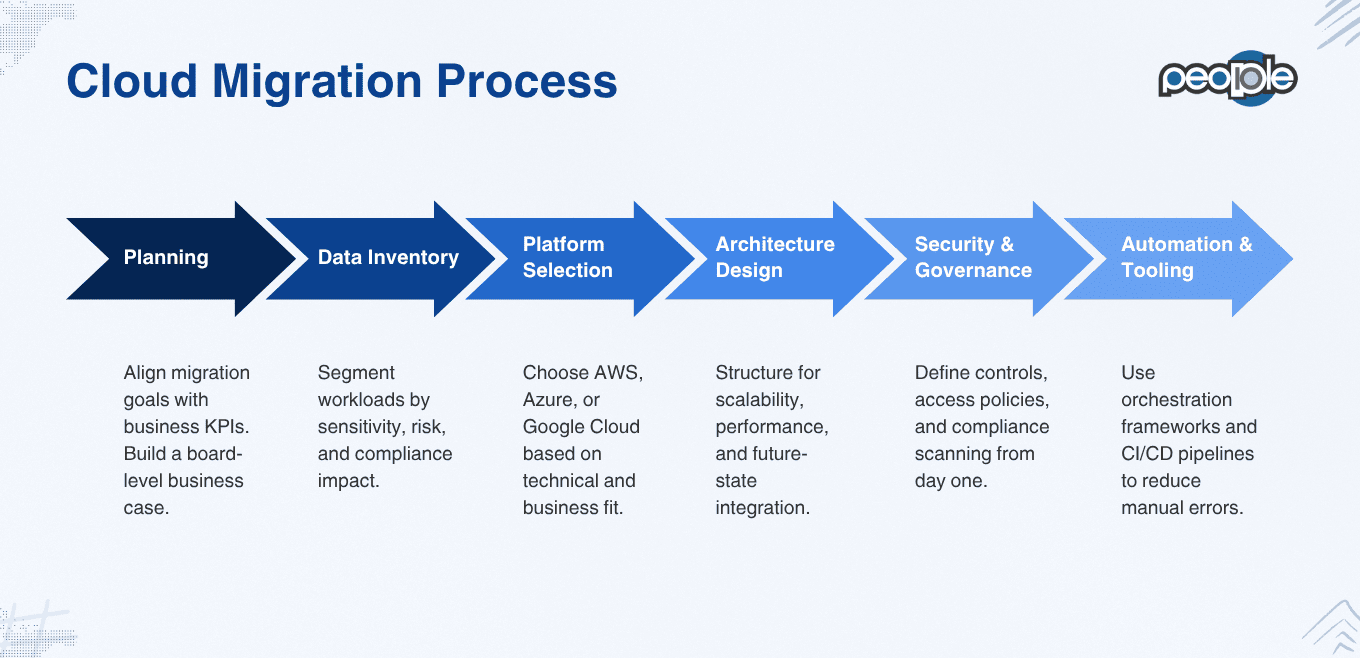Cloud data migration is a high-stakes business initiative that enables agility, resilience, and innovation. You must drive digital transformation by aligning infrastructure with long-term goals and delivering business value at scale, making an effective migration strategy critical to success.
This shift is fundamental to digital transformation efforts across many industries and sectors.
It enables companies to adopt new technologies and remain competitive in a rapidly evolving digital economy.
Through cloud data migration, businesses gain improved data management, enhanced collaboration, and stronger disaster recovery capabilities. In this guide, we explore essential principles, proven best practices, and important considerations for a successful migration process.
Why Cloud Data Migration is Critical for Your Business

As digital transformation accelerates, over 52% of companies have moved core infrastructure and analytics to the cloud. Cloud data migration is a critical strategic initiative that significantly influences operational efficiency and long-term success. According to a report by Foundry, 52% of companies have migrated a majority of their IT environments to the cloud, including infrastructure, applications, and data analytics.
As organizations strive to become more data-driven, migrating to the cloud provides a solid foundation for growth. It helps companies remain competitive in today’s fast-paced digital landscape.
For technology executives, the motivation extends beyond agility:
- Faster go-to-market: Infrastructure elasticity helps product teams deploy and iterate quickly.
- Increased resilience: Disaster recovery and business continuity planning are easier to implement.
- Platform for innovation: AI, ML, and data analytics become accessible and scalable.
- Improved cost visibility: Pay-as-you-go models enable better financial oversight.
The Challenges of Cloud Data Migration
Cloud data migration offers immense benefits, but the path to a successful transition is often complex. Migrating large volumes of data across varied systems while ensuring seamless functionality post-migration presents significant challenges.
Additionally, aligning all stakeholders on the migration process, timelines, and objectives requires meticulous planning and clear communication to avoid disruptions.
CTOs must anticipate pitfalls to ensure a smooth transition:
- Legacy compatibility: Adopt a hybrid integration strategy with API layers or containerization.
- Data integrity risks: Run dry runs and parallel validation to prevent loss or corruption.
- Compliance management: Embed controls early to address GDPR, HIPAA, and SOC 2.
- Resource contention: Assign a dedicated Cloud Center of Excellence (CCoE) to oversee migration.
The Cloud Migration Process: Key Considerations for Cloud Data Migration


When migrating to the cloud, businesses must address several key factors to ensure a smooth transition. Each decision made during the migration process has long-term implications, and careful planning is required to mitigate risks and optimize results.
Build a Business-Case Aligned Migration Plan
Map cloud objectives to business outcomes: cost reduction, innovation cycles, or global scalability. Present KPIs to the board, such as reductions in lead time, improvements in uptime, or boosts in deployment frequency.
Create a Prioritized Data Inventory
Segment workloads by sensitivity, latency requirements, and regulatory implications. Begin with low-risk datasets to establish confidence.
Choosing the Right Cloud Platform (AWS, Azure, Google Cloud)
Selecting the right cloud platform is one of the most critical decisions in the cloud migration process. Leading platforms, such as Amazon Web Services (AWS), Microsoft Azure, and Google Cloud, offer various features and pricing models that cater to different business needs.
- AWS: Broad tooling, maturity, and scalability.
- Azure: Strong for Microsoft-integrated enterprises.
- Google Cloud: Best-in-class for AI/ML and analytics workloads. Engage a vendor-agnostic advisor to match platform capabilities with enterprise goals.
Case Study: Modernizing Educator Hiring with Azure-Powered Real-Time Job Alerts
To streamline recruitment workflows for school districts, People10 modernized a regional educator job portal using Angular 14+ and Azure-based microservices. The platform enabled real-time job notifications, editable job drafts, and full job history tracking. Built with Azure Event Grid and Notification Hubs, the system achieved a 50% improvement in portal load time and reduced listing errors by 25%, while boosting admin engagement by 15%.
Download the case study to see how People10 builds scalable, event-driven platforms that transform hiring experiences.
Consulting with experts during this phase can ensure that you select the platform that best supports your goals and long-term vision.
Understanding Your Data Requirements and Structure
Before migrating data to the cloud, businesses need to gain a clear understanding of their data requirements and structure. This includes identifying the types of data that need to be migrated, the volume of data, and how the data is organized. Different types of data—such as transactional, historical, and operational data—require varying handling, storage solutions, and security measures.
Enforce Security and Governance from Day Zero
Define a governance model with identity management, encryption, and audit logging. Integrate continuous compliance scanning using tools such as Prisma Cloud, Wiz, or native CSPM solutions.
Planning for Data Security and Compliance
Security and compliance are paramount considerations during cloud data migration. Businesses must ensure that their cloud platform provider adheres to relevant industry regulations such as GDPR, HIPAA, or SOC 2.
A comprehensive data security plan should be established, covering areas such as encryption, access control, and vulnerability management. Furthermore, businesses should implement monitoring systems to detect any potential security threats during and after the migration process. Ensuring that the migration process complies with legal and regulatory standards reduces the risk of costly penalties and protects sensitive data.
Use Automation to Orchestrate Migration at Scale
Invest in orchestration frameworks (Terraform, Ansible, Pulumi) and automate testing and validation through CI/CD pipelines. Leverage cloud-native tools for replication, cutover, and rollback.
Risk Management and Minimizing Migration Failures
Migration success begins with stability, control, and confidence in execution. CTOs and CIOs must lead with structure and discipline.
- Start by designing a risk plan aligned with business goals. Run a pilot migration for non-critical workloads to validate systems and processes.
- Create full backups and version-controlled snapshots before moving production environments. Test rollback procedures and restore points in advance.
- Assign risk ownership to a Cloud Program Lead or Cloud Center of Excellence.
- Ensure cross-functional alignment across security, ops, and compliance. Use automated testing tools to validate each phase.
- Identify errors in real time and maintain full visibility across environments.
- Simulate failure scenarios in controlled sprints. Document contingency steps and escalation protocols to avoid last-minute confusion. Focus on prevention, not recovery. With proactive controls, migration becomes a low-risk, high-value initiative.
You manage risk early, protect uptime, preserve trust, and accelerate business outcomes.
Best Practices for Successful Cloud Data Migration
Cloud migration delivers value when executed with precision and purpose. A structured approach ensures success across business and technical dimensions.
Following proven best practices helps mitigate risk, reduce downtime, and accelerate time to value. Below are key actions for effective execution.
Conducting a Thorough Data Assessment
Start by auditing your current data infrastructure and classifications. Identify data types, sensitivity levels, and integration dependencies. Document volume, usage patterns, and compliance requirements. Use this insight to plan efficient structuring, storage, and access in the cloud.
Address issues such as redundancy, inconsistent formatting, and security gaps. A strong data foundation improves migration speed and quality.
Establishing Clear Migration Objectives
Define business outcomes and technical priorities. Align all stakeholders with goals that support transformation and long-term innovation. Typical objectives include reducing costs, increasing scalability, or improving data governance. These goals guide design and execution choices.
Use objectives to establish benchmarks, allocate resources, and measure ROI. Strategic clarity ensures faster decision-making throughout migration.
Implementing a Phased Migration Approach
Break migration into controlled phases. This improves risk management and helps maintain stability during the transition. Begin with low-risk workloads to test performance and process reliability. Apply lessons learned before scaling to mission-critical systems.
Each phase should include rollback options and validation steps. A phased plan reduces errors and avoids large-scale disruption. It also minimizes the risk of data loss or system downtime during migration.
Ensuring Proper Data Mapping and Validation
Map source systems to target cloud environments with precision. Maintain structure and relationships across datasets.
Perform pre-migration checks to ensure compatibility and completeness. Fix gaps and inconsistencies before transferring live data. Run post-migration validation to confirm accuracy, performance, and usability. Testing is essential to avoid long-term operational issues.
Leveraging Automation and Tools for Efficiency
Use cloud-native migration tools to reduce manual effort. Automate replication, scheduling, and monitoring workflows at scale.
Platforms such as AWS Migration Hub and Azure Migrate enable orchestration and visibility. Choose tools that align with your architecture. Automation reduces errors, accelerates delivery, and frees engineers to focus on strategic oversight and optimization.
Continuous Testing and Validation During Migration
Test after each migration phase. Validate accuracy, performance, and business logic under real operating conditions. Include integration, access control, and performance benchmarks in every round of testing. Monitor results in real time.
Address issues before progressing to the next phase. Continuous validation ensures control, predictability, and stakeholder confidence.
Tools and Technologies for Cloud Data Migration
Successful migrations depend on using the right tools. The correct technology stack enables accuracy, automation, and operational control.
Below are essential tools you should evaluate when planning enterprise-grade data migration.
Cloud Migration Tools and Services (e.g., AWS Migration Hub, Azure Migrate)
Start with cloud-native migration tools. These platforms simplify orchestration and reduce complexity across hybrid and multi-cloud environments.
AWS Migration Hub centralizes migration tracking and supports visibility across workloads. It improves coordination across technical teams.
Azure Migrate assists with discovery, assessment, and execution. It ensures compatibility and scalability within the Microsoft ecosystem.
Both platforms offer prebuilt automation, monitoring, and integration features. These accelerate delivery and increase predictability.
Leveraging APIs for Data Transfer
APIs create the bridge between legacy systems and cloud platforms. Use them to automate and standardize data flow.
APIs reduce manual intervention and ensure secure, structured data transfers. They also allow parallel system operations during migration.
For complex architectures, APIs provide abstraction. This minimizes disruption and allows for phased deployments.
Automation Platforms to Streamline Migration
CI/CD tools like Jenkins, CircleCI, and Travis CI support migration through repeatable, automated pipelines.
Use automation to manage code integration, validation, and deployment tasks. This reduces latency and avoids manual bottlenecks.
Automated workflows increase reliability and ensure consistent performance across environments. They also simplify rollback and version control.
Integrating Data Management Solutions During Migration
Incorporate data management tools to maintain governance and quality. These platforms classify, validate, and monitor enterprise data.
Solutions such as Informatica, Talend, or Apache Atlas track lineage, control access, and enforce policy compliance.
This integration supports regulatory alignment, security enforcement, and long-term data usability in the cloud environment.
Post-Migration Strategy for Cloud Data Migration
Cloud success continues after migration ends. Post-migration strategy ensures performance, security, and cost optimization remain on track. Organizations that monitor cloud efficiency realize greater ROI. As per a report by Flexera, 65% of organizations measure cloud progress through cost savings. It highlights the importance of continuous optimization for cost management.
Monitoring and Optimizing Data Performance in the Cloud
Monitor cloud performance continuously after migration. Track network behavior, application health, and infrastructure usage in real time.
Use monitoring tools to detect latency, bottlenecks, and underperforming systems. Address performance issues before they affect users. Optimize compute, storage, and bandwidth resources. Regular performance tuning ensures consistent speed, uptime, and user experience.
Setting Up Data Governance and Security Protocols
Establish governance frameworks immediately post-migration. Define ownership, access controls, and lifecycle policies for all data assets.
Enforce encryption, audit logging, and identity-based access. These safeguards protect data across storage, transit, and compute layers.
Use frameworks such as SOC 2, HIPAA, or GDPR as a baseline. Regulatory compliance must remain continuous and audit-ready.
Setting up these protocols ensures the continued protection of sensitive business data and compliance with regulations such as GDPR, HIPAA, and SOC 2.
Continuous Optimization for Cost Management
Track cloud consumption patterns regularly. Right-size resources based on usage trends and workload criticality.
Enable autoscaling, reserved instance purchases, and cloud budget alerts. These adjustments reduce unnecessary expenditure and the risk. Align cost optimization to KPIs and business outcomes. A FinOps model enhances transparency, forecasting, and unit economics.
Optimizing cloud resources on an ongoing basis ensures that businesses are getting the best value from their cloud investment.
Ensuring Ongoing Compliance and Security Updates
Keep cloud environments compliant and secure. Regularly apply patches, updates, and security configurations across all environments.
Use CSPM tools to scan for misconfigurations, drift, or outdated components. Automate alerts for real-time visibility and response. Maintain compliance documentation and evidence trails. Staying audit-ready minimizes legal risk and ensures policy alignment.
By adhering to these post-migration strategies, businesses can ensure that their cloud environments perform optimally and provide long-term value.
Continuous monitoring, optimization, and compliance efforts contribute to the ongoing success of cloud data migration initiatives.
Conclusion: Cloud Data Migration for Business Growth
Cloud migration drives business growth by enabling scale, operational efficiency, and responsiveness in competitive markets. To capture these benefits, technology leaders must lead with clarity, measurable goals, and enterprise-wide alignment.
That is why strategic execution is essential—not just for migration, but for unlocking long-term innovation and resilience.
At People10, we help you operationalize migration programs with structure, security, and business impact.
Our solutions combine deep platform expertise with governance, automation, and risk management built for scale.
If you are planning to modernize, let us help you build a future-ready infrastructure.
Author
Shrutha Sekharaiah brings over 13 years of experience in delivering innovative, scalable solutions. His broad expertise in technology and focus on collaboration and mentorship drive the creation of robust systems enhancing efficiency and performance.




